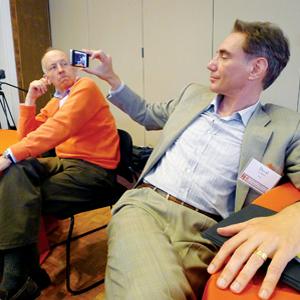The narrative of freedom is being told at Stanford University this week, in the same way that it’s been told across the world for months, as journalists from countries crumbling and developing have come to Palo Alto to stay a step head of the social-media curve.
There are probably only a handful of ink-stained print reporters in the room on the opening day of the Eighth Conference of Innovation Journalism, which might explain why everyone seems so happy. Eight people sit at a table, leisurely sipping coffee and passing glances among one another, and occasionally toward the front of the room. When their attention wanes, they go back to their Twitter feeds, tapping away on iPads, smart phones and laptops.
There are ten other tables of people in this filled-to-capacity ballroom, many from outside the United States. In recognition of current events, Stanford invited several journalists and bloggers who participated in the recent upheavals in the Middle East.
It is not a universal digital love fest, however. At this moment, everyone’s attention is directed toward a spectacled man slight of frame who peers over a podium and grins devilishly.
“You’re just an algorithm,” says David Burk of the international PR firm Fleishman-Hillard, who contends that the public’s access to media has become sharply limited by websites that track user interest and provide a small, customized sampling of information.
Despite the plethora of information, Burk says, “there is no journalism.” He concludes: “I hope I’m not controversial.”
Burk’s observations about news, search engines and social media elicit some chuckles, buoyed by optimism and weighted by anxiety. At the so-called “IJ8” confab, it’s as if the manifest destiny of the industry and the pitfalls of the great frontier have finally confronted one another.
Traditional media has never been so unnerved as it confronts reports about its insignificance and mortality. Simultaneously, the individual has never been so empowered.
Innovation takes many forms, which is why the three-day conference, which concludes Wednesday, is tackling not only the new generation of journalists who will be telling the stories of tomorrow, but the vast amount of avenues to be exploited.
{pagebreak}
“Today, power is moving from parliaments to boardrooms,” says David Nordfors, the executive director of the Stanford Center for Innovation and organizer of the conference. “The Arab uprising is probably the first time that I know of that companies in Silicon Valley are seen as more influential in the Arab world and geo-politics than the state department. There’s more about Facebook’s influence or Google’s influence than actually the U.S. federal government’s influence on what’s happening on the streets or in this country in general.
“Before we were only talking about the zero-sum game, ‘What should we allow? What should we forbid?’ And now we’re talking about innovation.”
Storytelling has become an amalgamation of prose and programming. Words are no longer the only tools for constructing a narrative. Paradoxically, IJ8 attendees see video as both the most powerful means and the biggest potential threat to journalistic integrity, because the lens only captures what is within the frame.
As with any academic setting, there is no shortage of the old guard bemoaning the loss of language via the long-form narrative, or the abundance of voices shouting for attention inside the media sphere. Geoffrey Moore, a partner at the venture firm Mohr Davidow, has mixed emotions about what he calls the “century of awakening.”
Moore says Silicon Valley has a rightful claim as the epicenter of innovation, and the “game is being played on the information level, not the physical level.” But he warns that as timeliness becomes the most valuable currency, news becomes a random collage rather than a refined portrait of a situation.
The web to some extent diminishes the authority of the author—a dangerous proposition if people don’t know where they’re getting their information. “When accountability is lost, credibility is suspended,” Moore says.
The winners, then, are celebrities, advertisers and online “content” professionals, Moore says, while publishers, journalists and marketing professionals are left wondering where they fit. The result could be a media glut, where the public is left wondering what’s on the other side of the search engine wall that says “This is what we think you should be interested in.”
“The big assumption is that we live in a pluralistic society, and everyone is going to cancel each other out through fact checking,” Burk says. “I hope that’s where it goes and there’s discourse about this. But right now I don’t think there’s a lot of discourse, and that’s the problem. Eventually, I hope everyone comes back together and there’s more back-and-forth rather than completely divergent views.”
Youth Movement
For Esther Wojcicki, a teacher at Palo Alto High School, innovation is allowing for a wave of expansion to a younger demographic. Wojcicki oversees a rare journalism program in this age of K-12 education cutbacks, where 650 students are delivering daily content in print, on the web, and directly to smart phones and tablets.
“I’m kind of like the orchestra director,” she says. “I wave the wand and they do all the work. I find this is the most effective way to empower kids. I tell them it doesn’t matter if you become a journalist or a doctor; you need these skills to think.”
The thought process on how to translate innovation into dollars continues to be a mystery.
Tom Foremski, formerly a reporter for the Financial Times who now runs the website Silicon Valley Watcher, says new outlets will have to take a collaborative approach.
Questions surrounding access to information will no doubt persist, but for now, innovation has opened doors that cannot and should not be closed.
“If we want to live in a democracy,” Nordfors says, “we have to have storytellers who can facilitate a discussion between citizens and people with power. It’s a different game.”

 Veterans Dominate Amgen Tour
Veterans Dominate Amgen Tour  Food & Wine Events: May 25-June 1
Food & Wine Events: May 25-June 1 







